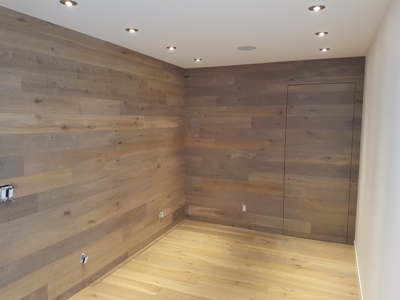Fenstür Windows and Doors, a manufacturer and direct retailer of high-end custom-built residential wooden doors and windows, has begun replacing fiberboard cores in its doors with a unique composite core produced by RhinoKore Composite Solutions (Armstrong, B.C., Canada). The composite cores offer a number of benefits, the most important of which is more than halving door weight, which eases handling and installation of the door at the construction site, plus brings the carry-over benefits of mass decompounding, such as being able to use smaller and lighter hardware to hang the doors. Additionally, the new cores improve dimensional stability and thermal insulation (R value is 3.15 to 3.19 per 1 inch/2.5 centimeter thickness), and they also proved to be a drop-in replacement during the manufacturing process without a need to modify anything, including the adhesive.
The collaboration began at the recommendation of a local builder who was working on a residential construction project where Fenstür was asked to produce a custom interior door for a walk-in cooler. The homeowner wanted a cold room with a hidden door to hold game, food, and wine. The unique oversize door is designed to blend into the wall when closed, hence it features concealed hinges and a removable spindle that functions as a handle. The side of the door facing the inside of the cooler is finished in birch wood to match the cooler interior, while the outside (exercise room-facing side) of the door is covered with hackwood to match floors and walls in that room.
The door was built before the exterior/exercise-room was paneled with hackwood. Wood for that side of the door was brought to Fenstür's shop and laid out across the door and marked. Board offcuts were then made and labeled so they could be attached to the walls adjacent to matching boards on the exterior/warm-room side of the door. This extra effort allowed the team to "board match" paneling on the exterior of the door so the grain lines up and continues onto the walls, helping the door blend even better into the exercise room.

Due to the significant differences in both temperature and humidity anticipated between the cold/dry cooler-facing side of the door and the warm/humid exercise room-facing side, the Fenstür team knew the door would need to be thicker than normal (2.25 inches/5.72 centimeters) to provide insulation. However, a door that thick and large (42 by 84 inches/107 by 213 centimeters) using a conventional fiberboard core was also going to be very heavy, which would bring numerous challenges. That's when the local builder mentioned RhinoKore's unique composite core as a possible solution to replace the heavy fiberboard.
The patented honeycomb core is made from a tough, heavy-duty fabric woven with nylon (polyamide) and polyester fibers. The fabric is fed into a custom-built "honeycomb" machine where it is quickly exposed to hot air (427°C/801°F), which heats and softens the fibers and allows them to be manipulated and formed easily. The fabric is then pressed into sheets of conjoined hexagonal cells (13 mm/0.5 inch in diameter with 1.1 mm/0.04 inch walls) and cooled. Next, the solidified honeycomb sheets (122 centimeters/4 feet wide by 244 centimeters/8 feet long by 152 mm/6 inches thick) are removed and placed in a mold, where a two-part, closed-cell polyurethane foam is injected into all the cells and allowed to cure in a heated press. The finished core is then sliced to thicknesses ranging from 0.25 to 6.0 inches/0.64 to 15.2 centimeters and then can be bonded to faceskins of thermoplastic or thermoset composite, metal, wood, or even concrete. The honeycomb core has a very-good stiffness- and strength-to-weight ratio and helps improve the structural integrity ― especially torsional rigidity ― of any structure to which it is bonded. It is dimensionally stable and provides very-good compression and shear strength, as well as thermal and acoustical insulation. At any thickness, the core offers excellent impact strength (energy absorption/damage tolerance). And unlike fiberboard, it is impervious to water and will not trap moisture or rot. It also is much lower in density than fiberboard, which helps reduce part mass significantly.
The Fenstür team built the door using the composite core and found that it was a drop-in replacement for the fiberboard they'd previously used. Nothing had to be changed in the production process ― even the adhesive (polyvinyl acetate (PVA, also known as white carpenter's glue)) they had previously used to bond fiberboard to wood faceskins could be used with the honeycomb core. The final door consisted of 0.75 inch/1.9 centimeter-thick layer of hackwood paneling on the outside, a 1 inch/2.5 centimeter-thick composite core, and a 0.5 inch/1.3 centimeter-thick layer of birch paneling on the inside. Once the new door was assembled, Fenstür's carpenters and finishing specialists were amazed to see that it was less than half the weight it would have been with a fiberboard core. It also was quieter and took less effort to open and close. The team knew that that would not only make it less costly to ship to the work site, but would make it easier for the local builder's construction crew to hang and true the door. They also felt that door sag would not be an issue, since the hinges were not stressed thanks to the reduction in door weight. The weight reduction is significant as on a conventional 50 by 100 inch [125 by 250 centimeter] door that can weigh 400 to 500 pounds [181 to 227 kilograms] with a fiberboard core, it has been reduced to about 150 pounds [68 kilograms]. "
Going forward, the company plans to offer the composite core as a premium upgrade for a modest cost increase and will begin experimenting to see if it can be used for windows as well. Access to the technology has made company management more confident in bidding on very-large doors, which could open up a new market segment for them.
Fenstür Windows and Doors was established in Duncan (Vancouver Island), B.C. in 2014 with the goal of building superior, custom-made wooden doors and windows that combine the best of traditional woodworking techniques and modern technologies sourced from around the world. The family owned and operated business is dedicated to supporting local economies and sustainable development by using local labor and materials whenever possible. With 150 years of combined forestry and engineering experience, the Fenstür team includes civil engineers, foresters, carpenters, and finishing specialists who search for the best products and newest technologies, and watch the latest trends in order to craft dependable, highly customizable, and high-performance products.














